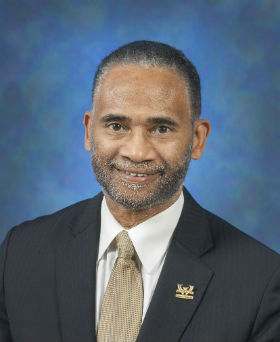Richard Baker, M.D., senior vice dean of Medical Education for the Wayne State University School of Medicine, helped develop a series of workshops on diversity, equity and inclusion in health professions for the National Academies of Sciences, Engineering and Medicine.
Dr. Baker, a professor of Ophthalmology, served as vice chair of the planning committee that produced “Exploring a Culture of Fairness, Respect and Anti-racism Through Diversity, Equity and Inclusion in Health Professions Education: A Workshop Series” for the organization.
Dr. Baker’s committee convened a diverse group of educators, students, administrators and health professionals to explore diversity, equity, inclusion and anti-racism across the spectrum of health professions education. The participants shared ideas and educational materials that resulted in an interactive webpage tool for educators and health professionals to explore ideas and responses by considering:

• Accreditation as a mechanism for change
• The importance of language for sparking action
• How metrics and funding organizations are, or could be, used in measuring and promoting anti-racism structures of institutions
Each session explores forms of institutional structures as potential mechanisms for influencing or eliminating discriminatory practices within the education of health professionals. All three workshop sessions are summarized in the resulting free interactive educational resource, complete with downloadable content.
In addition to overseeing the committee that planned the workshop, Dr. Baker presented “Five Foundational Points,” which form the core of the program. His five points, which he described as “admittedly aspirational,” are “useful in facilitating a common understanding of the topic for a more focused and intentional discussion.”
The points include:
1. DEI - diversity, equity, and inclusion - is not the same as “anti-racism”
Make a clear distinction between the DEI efforts and anti-racism efforts. DEI is extremely important. It may be a pathway to, or a platform for, anti-racism, however, progress related to DEI should not be substituted or conflated with the achievement of goals related to anti-racism.
2. Race is not a biological construct
Race is not a biological construct, it is a social construct. Race as a biological construct is a pervasive and strongly held, but inaccurate belief and assumption. Science has definitively demonstrated that race is not based upon meaningful biology, it is at best a poor and often misleading proxy for real biological determinants of health, such as ancestry or genetic predisposition. Misrepresentation, particularly among our faculty and students, is highly problematic and it's a basis for perpetuating false beliefs, misinformation, inappropriate curriculum and inappropriate care.
3. Health inequities stem from racism and not race
Health inequities experienced by specific marginalized race, ethnicity groups are primarily the product and consequences of racism and not race. Racism is a powerful social determinant of health. Despite the undeniably powerful impact of racism on health, historically, the term racism has been typically de-emphasized, ignored, or actively avoided in discussions related to health.
4. Distinguish between structural racism and interpersonal racism
It's useful to distinguish between structural and institutional racism versus interpersonal racism. Discussions, activities and proposed interventions germane to anti-racism efforts in the health education environment primarily focus on structural and institutional racism, as opposed to interpersonal racism carried out at the level of the individual.
5. Structural racism extends far beyond the educational environment
Given the reality that structural racism extends far beyond the educational environment today, overarching questions are twofold. First, what is the role in the challenges of accreditors and recognizing and dismantling structural racism in the health professions’ arena? Second, what is the role and the challenges of creditors and mitigating structural racism’s pervasive and highly damaging effects on students faculty and the patients, we serve?